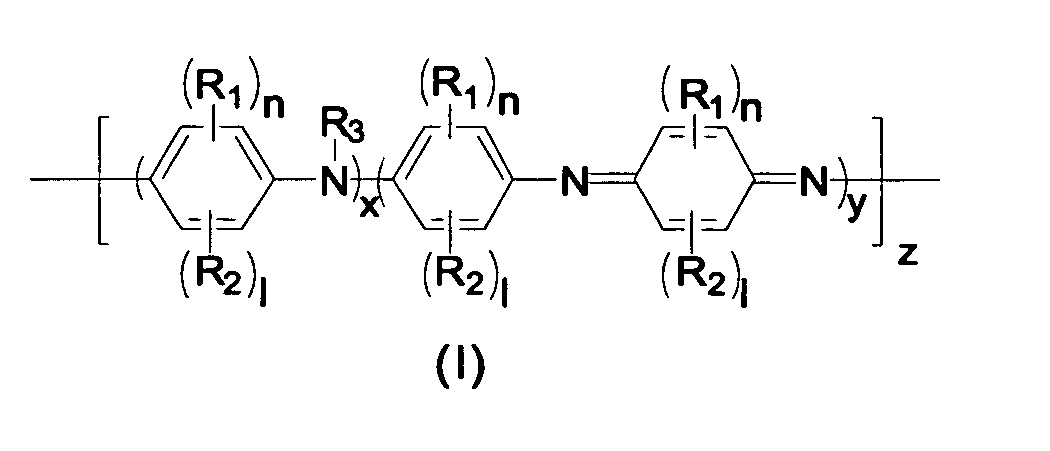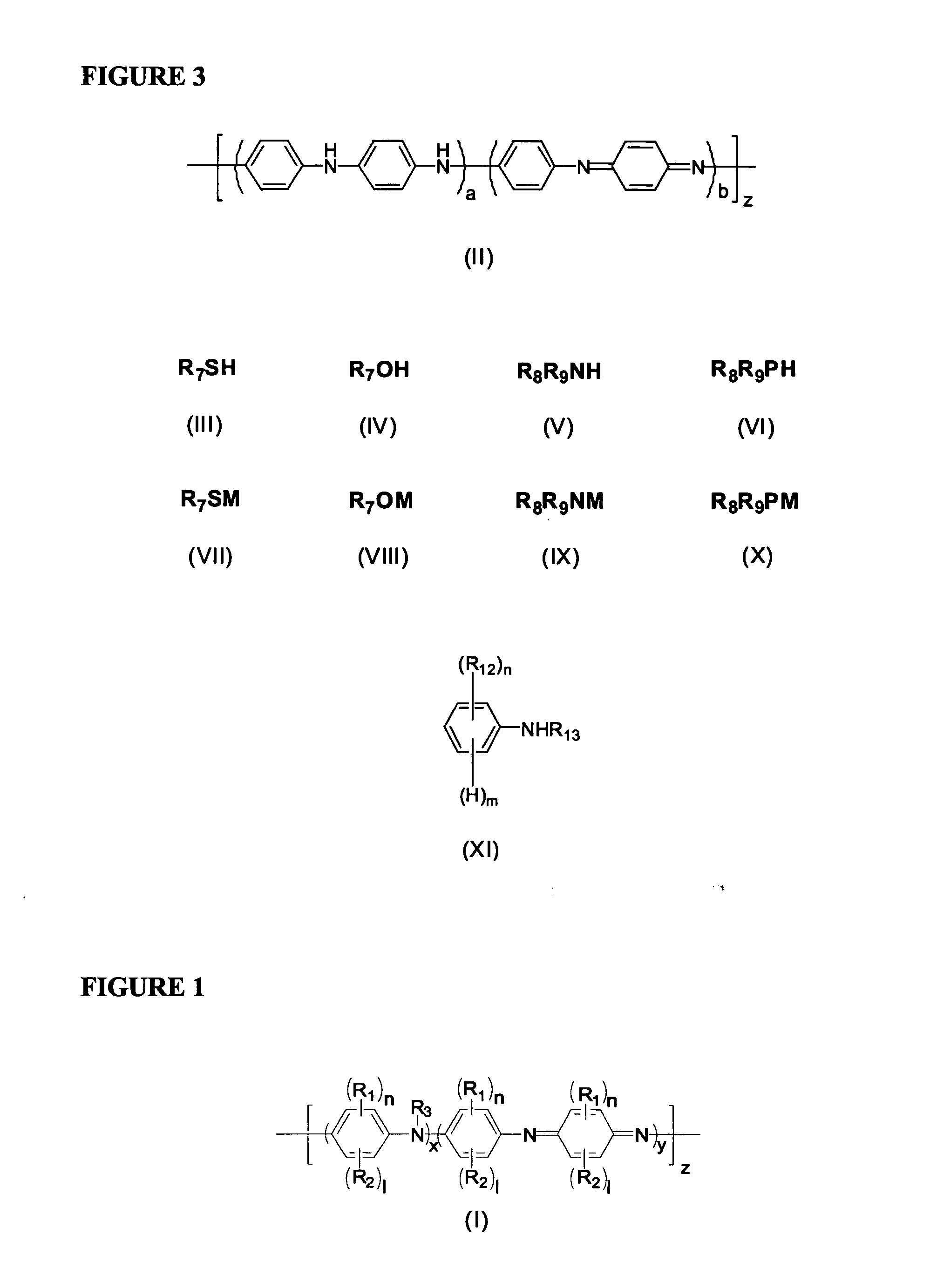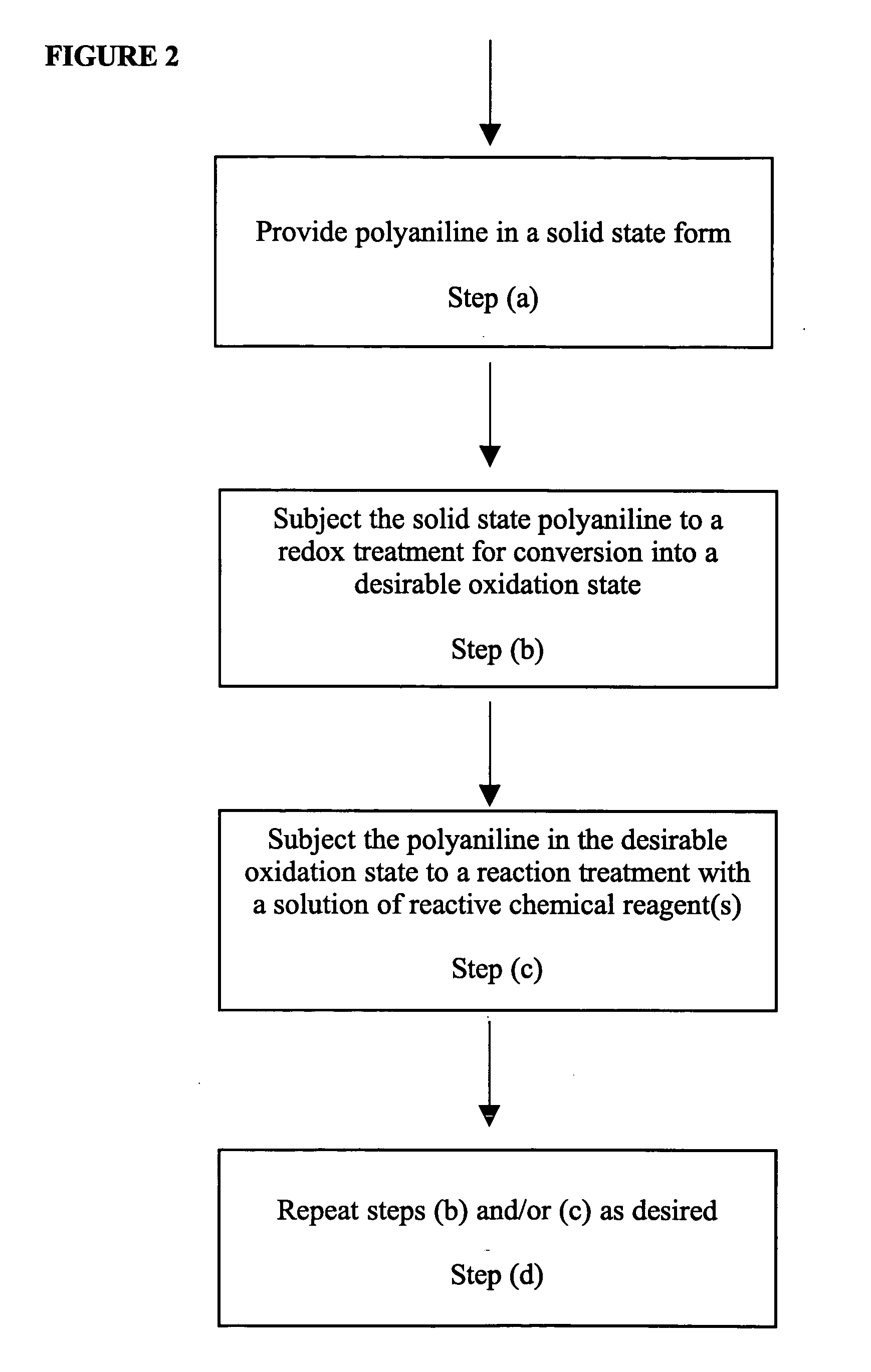Thermally stable self-doped functionalized polyanilines
a functionalized polyaniline, self-doping technology, applied in the field of polyanilines, can solve the problems of affecting long-term thermal and environmental stability, labile acid dopant evaporation loss, and degradation temperature of 180-190° c. may not be sufficiently high, and the conductivity of sulfonated polyanilines was also found to somehow decreas
- Summary
- Abstract
- Description
- Claims
- Application Information
AI Technical Summary
Benefits of technology
Problems solved by technology
Method used
Image
Examples
example i
Polyaniline powder is prepared by a chemical means by the following procedure. Aniline (50 g, 0.54 mole) and 204.4 g of p-toluenesulfonic acid monohydrate (1.08 mole, Aldrich Chemical) are dissolved in 1750 mL of H2O in a three neck round bottom flask equipped with a mechanical stirrer and an addition funnel. After the reaction mixture is cooled to 15 C, an aqueous solution of ammonium peroxysulfate (157 g in 270 mL H2O) is added dropwise through the addition funnel. The overall addition time was 2 h and 50 min. After the addition is finished, the reaction mixture is stirred for another 30 min.
The resultant solid is collected by filtration. The filtration cake is then dispersed and stirred for 30 min in 1.5 L of a 12 wt % aqueous solution of p-toluenesulfonic acid for four times. Each time, the solid is re-collected and then re-dispersed into a fresh p-toluenesulfonic acid solution.
After the above treatment, the filter cake is then dispersed and stirred for 30 min in 1.5 L of 8...
example ii
The undoped neutral polyaniline powder is prepared from the above p-toluenesulfonic acid doped polyaniline (i.e., poly(anilinium tosylate)) by dedoping with a base as described in the following. Poly(anilinium tosylate) (50 g) obtained in Example I is suspended in 500 mL H2O and stirred with 30 g of sodium carbonate at ambient temperature for 20 h. The resulting solid is collected by filtration and rinsed with 2 L of deionized water. The filter cake is dispersed in 1.5 L of deionized water and stirred for 4 h to remove sodium carbonate residue. The solid is then re-collected by filtration and rinsed with 2 L of deionized water. The resulting filter cake is air-dried at 25° C. for 20 h and then vacuum-dried at 80° C. for 3 h.
The elemental analysis results showed that the sample is free of dopant (S<0.03 wt %) and sodium carbonate (Na, non-detectable).
example iii
A freestanding film of about 10 μm (±2 μm) thick can be prepared from a NMP (N-methylpyrrolidinone) solution of the neutral polyaniline powder as prepared in Example II by the following procedure. A 0.48 wt % blue solution of polyaniline is prepared by dissolving the above dedoped polyaniline powder about 0.1 g in 25 mL NMP. After filtered off some small amount of insoluble solid, the resulting solution is cast into freestanding films on cleaned glass slides (7.5×2.5 cm in size), by carefully placing about 1.5-2.0 mL solution on each slide and pumping to dryness in a vacuum oven for about 24 h. A blue film with metallic shining is then formed, which can be peeled off by immersing the coated glass slide in methanol for 2-3 h.
PUM
| Property | Measurement | Unit |
|---|---|---|
| temperature conductivity | aaaaa | aaaaa |
| temperature | aaaaa | aaaaa |
| temperature | aaaaa | aaaaa |
Abstract
Description
Claims
Application Information
 Login to View More
Login to View More - R&D
- Intellectual Property
- Life Sciences
- Materials
- Tech Scout
- Unparalleled Data Quality
- Higher Quality Content
- 60% Fewer Hallucinations
Browse by: Latest US Patents, China's latest patents, Technical Efficacy Thesaurus, Application Domain, Technology Topic, Popular Technical Reports.
© 2025 PatSnap. All rights reserved.Legal|Privacy policy|Modern Slavery Act Transparency Statement|Sitemap|About US| Contact US: help@patsnap.com



